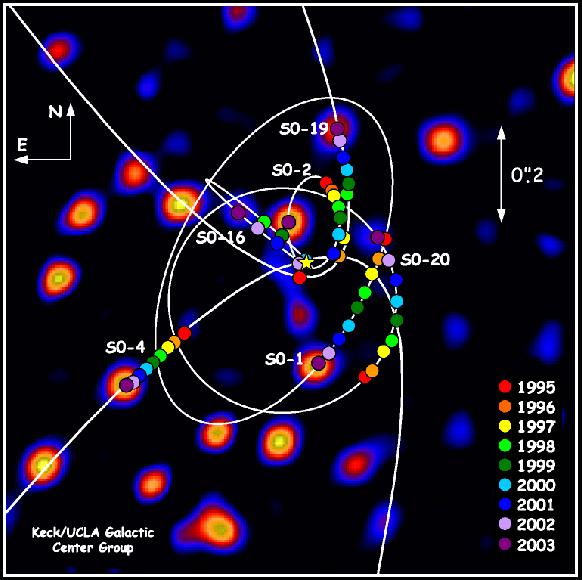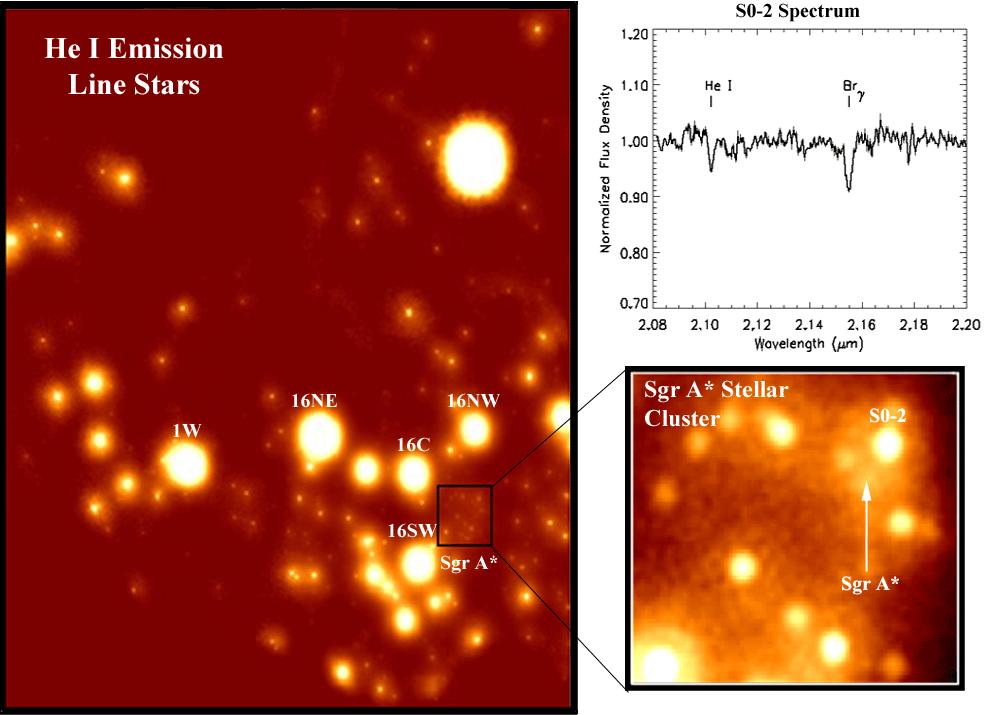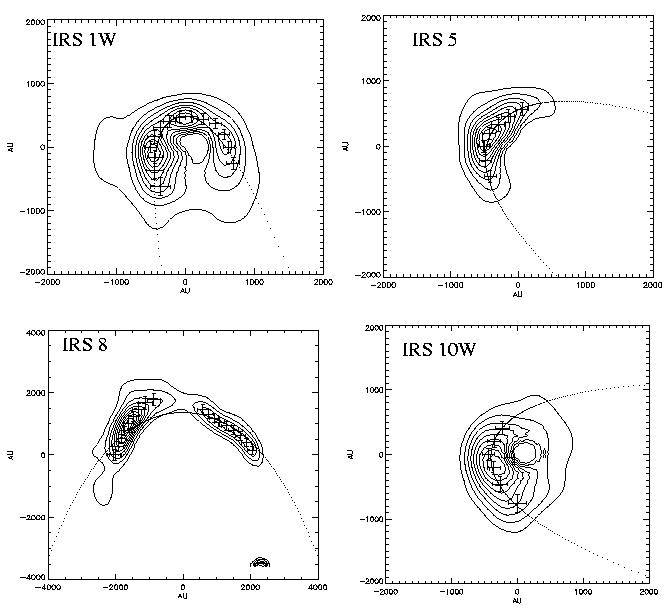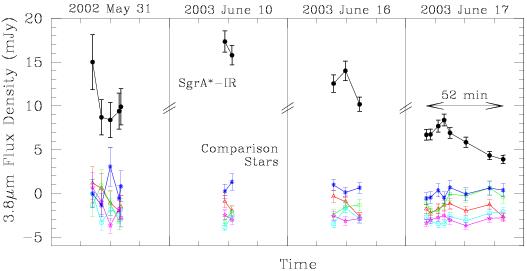
 GCNEWS
GCNEWS
A Newsletter for Galactic Center Research
This Volume was edited by Sera Markoff, Loránt Sjouwerman, Joseph Lazio, Cornelia Lang & Rainer Schödel
email: gcnews@aoc.nrao.edu

 GCNEWS
GCNEWS


A. M. Ghez
(Department of Physics & Astronomy, UCLA)

The proximity of our Galaxy's center presents an opportunity to build a case for a supermassive black hole and to study the black hole's environment and its effects thereon with much higher spatial resolution than can be brought to bear on any other galaxy. In this contribution, I've reviewed the progress that has been made based on data obtained at the W. M. Keck 10 m telescope. More images and animations can be found at: http://www.astro.ucla.edu/research/galcenter/.
After almost a decade of astrometry from diffraction-limited speckle imaging, we have moved the case for a supermassive black hole at the Galactic Center from a possibility to a certainty. Thanks to our recent ability to determine the orbits of individual stars, we have confined the central dark mass of 4 million times the mass of the sun to within 90 AU, or equivalently, 1,000 Schwarzschild radii (see Sect. 2 & Figure 1, on the cover and http://www.astro.ucla.edu/~jlu/gc/pictures/orbitsMovie.shtml. With the advent of adaptive optics, we have significantly expanded our studies of the Galaxy's central black hole through the addition of diffraction-limited spectroscopy and deep imaging at wavelengths other than 2.2 μms (for animation of the benefits of Adaptive Optics for studies of the Galactic Center see http://www.astro.ucla.edu/~jlu/gc/pictures/aoMovie.shtml. Spectroscopy has revealed that the stars orbiting in such close proximity are apparently massive and young; the origin of these stars is difficult to explain, given the strong tidal forces, and may provide key insight into the growth of the central black hole (see Sect. 3.1 & Figure 2). Further insight into the origin of a slightly different population of young stars, the He-I emission line stars, has come from a number of spatially resolved bowshocks (see Sect. 3.2 & Figure 3). Thermal infrared imaging (3.8 μms) has led to the direct detection of plasma associated with the central black hole. This source is variable on timescales as short as 40 min, implying that the emission arises quite close to the black hole, within 5 AU, or 80 Schwarzschild radii and providing a new, constantly accessible, window into the physical conditions of the plasma in close proximity to the central black hole (see Sect. 4 & Figure 4, also http://www.astro.ucla.edu/~jlu/gc/pictures/sgraMovieLp.shtml.
Significant progress on mapping out the distribution of dark matter at the center of the Milky Way has been made recently with diffraction-limited near-infrared studies of the central stellar cluster. The first phase of these experiments yielded proper motion velocities (Eckart & Genzel 1997; Ghez et al. 1998; Genzel et al. 2000), which suggested that 3 x 106 Mo of dark matter is confined to within 0.015 pc. This increased the implied minimum dark matter density by 3 orders of magnitude to 1012 Mo/pc3 and eliminated a cluster of dark objects as a possible explanation of the Galaxy's central dark mass concentration (Maoz et al. 1998), but still left the fermion ball hypothesis (e.g., Tsiklauri & Viollier 1998) as an alternative to a single supermassive black hole. The velocity dispersion measurements also localized the dark matter's centroid to within 100 mas and at a position consistent with the nominal location of the unusual radio source Sgr A* (Ghez et al. 1998), whose emission is posited to arise from accretion onto a central supermassive black hole (e.g., Lo et al. 1985). The detection of acceleration for three stars - S0-1, S0-2, and S0-4 - directed towards the same center, localized the dark mass to within 30 mas, increased the dark matter's minimum density to 1013 Mo/pc3, and thereby further strengthened both the case for a supermassive black hole and its association with the radio source Sgr A* (Ghez et al. 2000; Eckart et al. 2002).
Deviations from linear motions also initiated a new phase for these proper motion experiments - that of direct orbital studies. By making a number of assumptions, including fixing the central mass to the value obtained from the velocity dispersion analysis and its location to that inferred for Sgr A* by Menten et al. (1997), Ghez et al. (2000) and Eckart et al. (2002) obtained first crude orbital solutions; these experiments revealed that orbital periods for S0-2 and S0-1 could be as short as 15 and 35 years, respectively. With more of the orbit being traced, more precise orbital analyses have been carried out for S0-2 by Schödel et al. (2002), who dropped the mass assumption, and by Ghez et al. (2003) and Eisenhauer et al. (2003), who dropped both the mass and center of attraction assumptions and added radial velocity measurements. Most recently, we've carried out an analysis in which the orbits for multiple (8) stars are derived simultaneously so that they jointly constrain the central dark object's properties: its mass, its position and, for the first time using orbits, its motion on the plane of the sky (Ghez et al. 2004b). This analysis pinpoints the Galaxy's central dark mass to within 1.5 milli-arcsec (mas) and limits its proper motion to 0.8 +/- 0.7 mas y-1 with respect to central stellar cluster. This localization of the central dark mass is consistent with our derivation of the position of the radio source Sgr A* in the infrared reference frame (+/- 7 mas), but with an uncertainty that is a factor 5 times smaller, which greatly facilitates searches for near infrared counterparts to the central black hole. The estimated central dark mass from orbital motions is (4.0 +/- 0.3 ) x 106 (Ro/8kpc)3 Mo; this is a more direct measure of mass than those obtained from velocity dispersion measurements, which are as much as a factor of two smaller. Also, for the first time, the limiting source of uncertainty in the absolute mass is Ro, the Galactic center's distance, which adds an additional 19% uncertainty in the estimated mass. For stars in this sample, the closest approach is achieved by S0-16, which confines the mass to within a radius of a mere 90 AU (= 0.0004 pc = 1,000 Rsh) and increases the inferred dark mass density by four orders of magnitude compared to earlier analyses based on velocity and acceleration vectors, making the Milky Way the strongest existing case for a supermassive black hole at the center of any normal type galaxy.

With the introduction of an adaptive-optics-fed spectrometer on the W. M. Keck 10 m telescope, we have obtained the first detection of spectral absorption lines in one of the high-velocity stars in the vicinity of the Galaxy's central supermassive black hole (see Figure 2; Ghez et al. 2003). Both Brγ (2.1661 μm) and He I (2.1126 μm) are seen in absorption in S0-2 with equivalent widths (2.8 +/- 0.3 Å & 1.7 +/- 0.4 Å) and an inferred stellar rotational velocity (220+/-40 km/s) that are consistent with that of an O8-B0 dwarf, which suggests that it is a massive ( 15 Mo), young (<10 Myr) main sequence star. Less direct measurements of other stars within the central 1'' x 1'', which are known collectively as the Sgr A* stellar cluster, imply that these stars might be similarly young; specifically, their similar 2 μm luminosities and the lack of CO absorption in spectra of individual stars (Genzel et al. 1997; Gezari et al. 2002) or in integrated spectra of the Sgr A* stellar cluster (Eckart, Ott, & Genzel 1999; Figer et al. 2000) lead one to conclude that they, like S0-2, have hot photospheres consistent with massive young stars.
While the presence of young stars in close proximity to the Galactic black hole has long been recognized as a problem in the context of the young He I emission line stars (Sanders 1992, Morris 1993), this problem is much worse for the Sgr A* cluster stars, whose distances from the black hole are an order of magnitude smaller. At S0-2's apoapse distance of 0.01 pc, inferred from the orbital solutions, the Roche density is 1014 cm-3, whereas the maximum density determined for even the nearby circumnuclear disk, located at radii of 1-3 pc, is only about 105 cm-3 (e.g., Jackson et al. 1993). Furthermore, at present, the region over which S0-2 is currently orbiting contains only a very low-density plasma, as evidenced by weak Br-γ line emission (Figer et al. 2000; Gezari et al. 2002). It is therefore challenging to form these stars given the tremendous tidal forces presented by the black hole. Several ideas proposed to account for the apparently young He I emission line stars may be applicable to the Sgr A* cluster stars; 1) that the early-type stars are the result of stellar mergers in this dense environment (Lee 1996; Genzel et al. 2003a), 2) that they are exotic objects masquerading as normal stars (Morris 1993; Alexander & Morris 2003), 3) that they were formed by a cataclysmic compression of an already dense cloud which wandered into this region (Morris 1993; Levin & Beloborodov 2003), and 4) that they were formed elsewhere as part of a massive cluster, but migrated inwards rapidly by dynamical friction Gerhard 2001; Kim & Morris 2003; Portegies-Zwart, McMillian & Gerhard 2003; Hansen & Milosavljevic 2003). None of these possibilities is altogether satisfactory, leaving the stars in the Sgr A* cluster as a paradox of apparent youth in the vicinity of a supermassive black hole.

Our diffraction-limited images have resolved the mystery of an enigmatic class of cool, featureless sources known as the ``Northern Arm sources", due to their coincidence with the Northern Arm structure of gas and dust orbiting/infalling towards the central black hole. The detected bowshocks reveal these sources to be O/WR stars, which are massive young stars - analogous to the He-I emission line stars observed at comparable radii, that are plowing through the Northern Arm (Tanner et al. 2002, 2003, 2004). This increases the population of young massive stars within the central parsec, but more importantly, the bowshock geometry, their association with the Northern Arm, and their measured proper motions provide 6 phase-space coordinates, allowing us, for the first time, to test the hypothesis that this population of stars falls within two planes (Levin & Beloborodov 2003; Genzel et al. 2003b); these observations are not entirely consistent with the two-plane hypothesis (Tanner et al. 2004).
Our investigations into Sgr A* began with searches in our 36 nightly 2.2 μm maps for possible counterparts to the 3 hour flares detected by Chandra (Hornstein et al. 2002, 2003) The lack of a detection in these earlier maps are inconsistent with flares of the amplitude reported by Genzel et al. 2003 occurring 4-6 times a day, which may suggest that Sgr A* is more active now than it has been in the recent past. Furthermore a few of these non-detections are below the current 2.2 μm "quiescent" level. More recently, we have detected Sgr A* at L'(3.8 μm) with the W. M. Keck II 10-meter telescope (Ghez et al. 2004a). On four separate nights, its observed L' magnitude ranges from 12.2 to 13.8, which corresponds to a dereddened flux density of 4 - 17 mJy; no other source in this region shows such large variations in flux density - a factor of 4 over a week and a factor of 2 over 40 min. At these wavelengths, we did not detect a quiescent or steady state level; if it exists, it has to be below 4 mJy. In addition, it has a K-L' color greater than 2.1, which is at least 1 mag redder than any other source detected at L' in its vicinity. Based on this source's coincidence with the Galaxy's dynamical center, its lack of motion, its variability, and its red color, we conclude that it is associated with the central supermassive black hole. The short timescale for the 3.8 μm flux density variations implies that the emission arises quite close to the black hole, within 5 AU, or 80 Rs. We suggest that both the variable 3.8 μm emission and the X-ray flares arise from the same underlying physical process, possibly the acceleration of a small populations of electrons to ultrarelativistic energies. In contrast to the X-ray flares which are only detectable 2% of the time (e.g., Baganoff et al. 2001; Goldwurm et al. 2003), the 3.8 μm emission provides a new, constantly accessible, window into the physical conditions of the plasma in close proximity to the central black hole. This coming year is likely to bring many more exciting results on the variability of radiation from Sgr A* with several coordinated campaigns planned, involving facilities covering the X-ray, infrared, sub-mm, and radio portions of its spectrum.


References